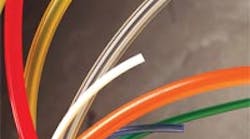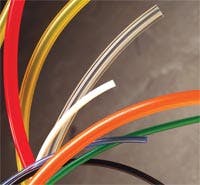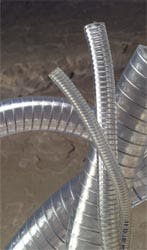Pneumatic Tubing — It's Mostly About the Material
For many pneumatic systems, tubing is an economical alternative to hose. And thanks to materials advances, choices for designers abound.
System designers can ensure topnotch performance and, at the same time, save a lot of money by substituting plastic tubing for reinforced hose in many pneumatics applications. Much like hose, it’s a well-established conductor for connecting pumps, valves, cylinders, and other components, and even for vacuum service. Some obvious selection factors include size and strength, but the wide range of available materials lets engineers tailor a system in terms of resistance to contaminants and the environment, flex and bending capabilities,and even color and appearance. Here’s an overview of some major types of tubing materials for pneumatics.
Polyurethane
Polyurethane combines the best properties of both plastic and rubber. It offers abrasion and tear resistance, high tensile and elongation values, and low compression set. Polyurethane is naturally flexible and exhibits virtually unlimited flexural abilities.
Combining good chemical resistance with excellent weathering characteristics sets polyurethane apart from most other thermoplastics. It has exceptional resistance to most fuels, oils, and other petroleum-based chemicals.
The two basic formulations of urethane, ester and ether, have some important differences. Water attacks ester-based urethane, significantly reducing physical properties. Ether urethanes have far superior hydrolytic stability, especially in humid environments. Ether-based materials also resist fungus growth better than their ester-based counterparts.
As one example, NewAge Industries manufactures a proprietary polyurethane tubing specifically designed for pneumatic applications. The tubing is made from ether-based polyurethane to resist attack from moisture. The flexible tubing permits tight bending in and around equipment, making it a good choice for pneumatic control, robotics, and automated machinery.
This tubing does not contain plasticizers that may leach out and contaminate flow. It offers cold temperature flexibility to as low as -90°F and virtually unlimited flexural life. It also resists pressure and vacuum better than corresponding sizes of PVC or rubber. For instance, 0.125-in. OD tubing (0.031-in. wall) has a 135-psi working pressure and 405-psi burst at 70°F.
In addition to uses in pneumatic control lines, air tools, lubricated air feeds, and vacuum equipment, the tubing is well suited for fuel and lubrication lines, instrumentation applications, and general fluid circuitry.
PVC
Although no one type of plastic tubing universally handles all applications, the PVC family of products covers one of the widest ranges of applications serviced by any material. Flexible PVC tubing offers broad chemical and corrosion resistance, excellent abrasion and wear resistance, rubber-like flexibility, and outstanding flow characteristics. Various construction options include wire or braid reinforcement, rigid pipe, and unreinforced, and different formulations – for instance, to meet FDA or NSF requirements.
In addition, most PVC tubing can be produced in custom sizes, colors, and shapes, and can be cut, printed, or thermally bonded. It is suited for pneumatics and pneumatic-conveying systems, as well as water, hydraulic, chemical, and refrigeration lines.
Nylon
Nylon is recognized as a rugged, light, corrosion and abrasion-resistant engineering plastic. For tubing, two important formulations are nylon-11 and nylon-12. They have similar physical properties and performance, but nylon-11 is available in a food grade version made of FDA-approved materials. Nylon-12 is typically used in industrial applications and is somewhat less expensive.
Nylon has exceptional elastic memory and can withstand repeated flexing over long periods of time without fatigue or fracture. This makes it a popular choice for retractable coils. Nylon also offers high-impact resistance, even at subfreezing temperatures, and low moisture absorption to ensure dimensional stability.
In addition to compressed air and pneumatic-control applications, nylon works wells in hydraulic lines and refrigeration, cooling, and air conditioning systems.
Polyethylene
Polyethylene (PE) is widely used with pneumatics, and its semi-rigid nature permits use with push-to-connect fittings without clamps. It is also one of the lower-cost plastic materials and satisfies many requirements that call for inexpensive, lightweight tubing. In fact, PE tubing is so light, it floats in water.
NewAge’s brand of PE tubing is a linear low density polyethylene formulation for repeated flexing with little or no signs of wear, and with better stress-crack resistance versus other low density materials. The resin is non-toxic, 100% virgin grade conforming to FDA requirements.
PE has long been recognized as an engineering plastic with a high degree of inertness, making it attractive for markets such as food and beverage, laboratories, and chemical processing where leaching or permeability would present risks.
Polypropylene
Polypropylene is the lightest of all thermoplastics available today and, like polyethylene, it will float. Other product features are excellent dimensional stability and electrical properties, good surface hardness and chemical resistance, and easy coloration. It can be sterilized at temperatures above 212° F.
The combination of polypropylene’s properties makes it desirable for a broad mix of applications. In many areas where fluoropolymer tubing is typically used, polypropylene tubing is a relatively low-cost alternative. The high-crystalline composition also makes it good for use in structural systems. Polypropylene tubing is weldable and, when welded, can be used in non-fluid transfer applications.
Suggested applications are compressed air, liquid dispensing equipment, electronic equipment, instrumentation and semiconductor manufacturing.
Other tubing materials
While not primarily used for pneumatics, these materials offer special characteristics that can come in handy in difficult or niche applications.
Fluoropolymers are some of the most versatile engineering materials known, with excellent heat resistance — up to 500°F continuously. Lesser known is its usefulness in extremely cold temperatures — well below -200°F. It remains reasonably flexible to -110°F. Fluoropolymers are almost universally inert to industrial chemicals and solvents, so tubing can handle virtually any corrosive chemical.
Latex is among the most flexible and elastic rubber materials. Resiliency is another quality of latex tubing, letting it maintain memory after repeated bending, stretching, or pulsing. Latex also withstands repeated sterilization with either steam, ethylene oxide, or gamma radiation. There are no added plasticizers, coagulants, or fillers to migrate and contaminate the fluid stream or cause tube hardening.
Silicone tubing and hose, made of a rubber-like thermoset material, is extremely pliable and elastic and not altered by the effects of weather. It is generally inert to UV, radiation, and ozone. Silicone tubing can meet the medical industry’s requirements for cleanliness and non-toxicity, and industrial grades offer high performance at relatively low costs. Another of silicone’s major features — resistance to extreme temperature variations — permits use in applications where flexible tubing is needed to handle temperatures not possible with other plastics or rubbers.
Thermoplastic rubber (TPR) combines the processability of plastics with the flexibility and durability of rubbers. TPR has outstanding compression characteristics, making it an ideal peristaltic pump tubing. The material also offers excellent resistance to flex fatigue and tear. It maintains good flexibility to temperatures approaching -80°F.
Two important versions are: FDA grade, natural in color and suitable for most clean needs, such as food and beverage or pharmaceutical processing and packaging; and black-colored industrial grade that offers exceptional resistance to UV, ozone, and other chemicals. It is well suited for outdoor use.
Viton, known for its resistance to oils and chemicals, retains good mechanical and chemical resistance properties at extremely high temperatures — better than any other known elastomer. Viton is also a standout material for i ts resistance to weather-related aging and ozone.
Viton’s fluid resistance far exceeds that of most other synthetic rubbers. It resists hydrocarbons such as benzene, carbon tetrachloride, toluene, and xylene — fluids that normally act as solvents on rubber, disintegrating the material, and leading to tubing failure. It also offers better resistance than most other thermoplastics.
For more information on pneumatic tubing, contact NewAge Industries at (800) 506-3924 or www.newageindustries.com.




